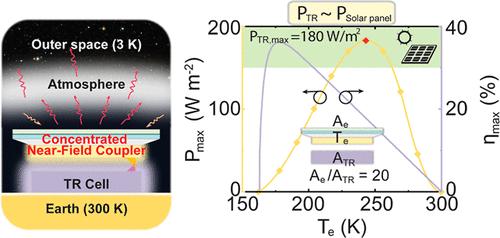夜间接近太阳能电池性能的集中近场热辐射装置
IF 16
1区 材料科学
Q1 CHEMISTRY, MULTIDISCIPLINARY
引用次数: 0
摘要
热辐射(TR)电池的工作原理是利用从地球向外太空发射的热辐射来吸收热量。尽管夜间发电机最近取得了进展,但TR技术面临着输出功率和效率低的挑战,远远低于其理论极限。在这封信中,我们研究了影响性能指标的关键限制因素。通过优化参数,引入由极性介电吸收器和集中热发射器组成的近场大气耦合器,最大输出功率可提高到180 W/m2,发射面积增加20倍,接近太阳能电池板的水平。此外,我们还探讨了材料选择和集成策略,以展示该技术的可行性和挑战。我们的研究结果表明,类似于聚光太阳能在太阳能发电领域的作用,这项技术可能预示着可再生能源发电领域研究人员的一个新兴前沿。本文章由计算机程序翻译,如有差异,请以英文原文为准。

Concentrated Near-Field Thermoradiative Device Approaching Solar Cell Performance at Nighttime
Thermoradiative (TR) cells operate by harnessing the outgoing thermal radiation from Earth to outer space to extract work. Despite recent advancements in nighttime power generators, TR technology faces challenges with low output power and efficiency, falling far less than its theoretical limits. In this letter, we investigate the key limiting factors affecting performance metrics. By introducing a near-field atmosphere coupler composed of a polar dielectric absorber and a concentrated thermal emitter with optimized parameters, the maximum output power could be boosted to 180 W/m2 with a 20-fold increase in the emission area, approaching the level of solar panels. Additionally, we explore material selection and integration strategies to showcase the feasibility and challenges of this technology. Our findings indicate that, analogous to the role of concentrated solar power in the solar power landscape, this technology could herald an emerging frontier for researchers in the field of renewable energy generation.
求助全文
通过发布文献求助,成功后即可免费获取论文全文。
去求助
来源期刊

ACS Nano
工程技术-材料科学:综合
CiteScore
26.00
自引率
4.10%
发文量
1627
审稿时长
1.7 months
期刊介绍:
ACS Nano, published monthly, serves as an international forum for comprehensive articles on nanoscience and nanotechnology research at the intersections of chemistry, biology, materials science, physics, and engineering. The journal fosters communication among scientists in these communities, facilitating collaboration, new research opportunities, and advancements through discoveries. ACS Nano covers synthesis, assembly, characterization, theory, and simulation of nanostructures, nanobiotechnology, nanofabrication, methods and tools for nanoscience and nanotechnology, and self- and directed-assembly. Alongside original research articles, it offers thorough reviews, perspectives on cutting-edge research, and discussions envisioning the future of nanoscience and nanotechnology.
 求助内容:
求助内容: 应助结果提醒方式:
应助结果提醒方式:


